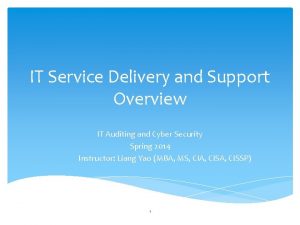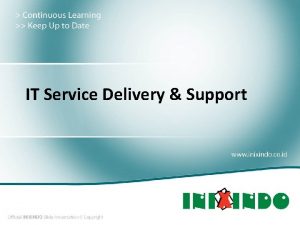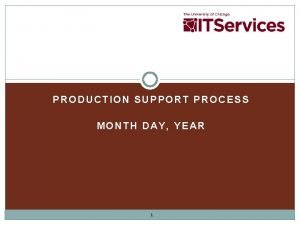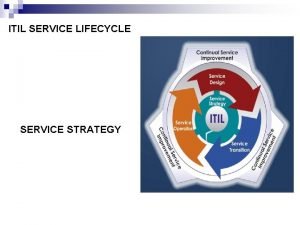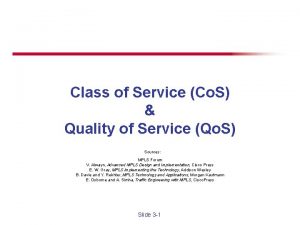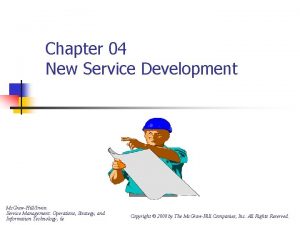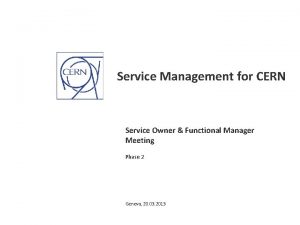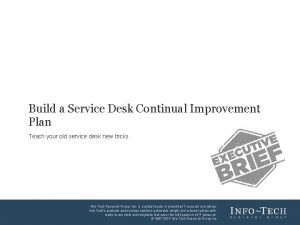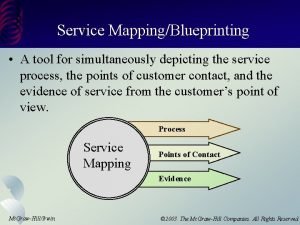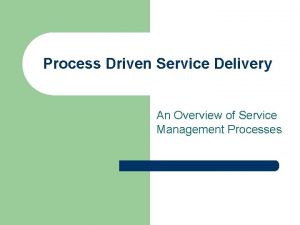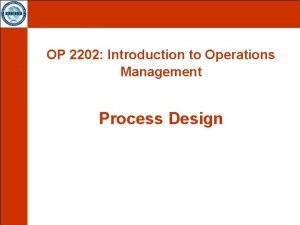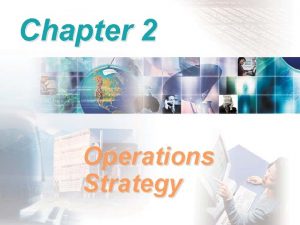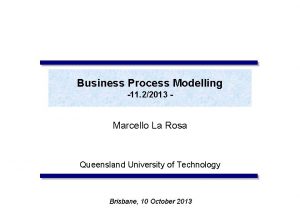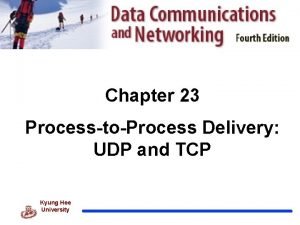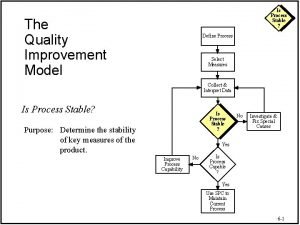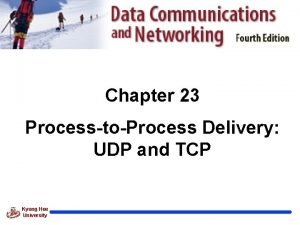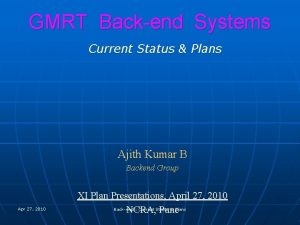Service Support Process Service Support Process Ajith G
















































- Slides: 48

Service Support Process • • Service Support Process Ajith G. S: poposir. orgfree. com

Service Support Process • Service support defines a framework that enables effective IT services. • Describes the day-to-day operation and support of the IT services. • Service delivery and service support processes are linked together through the Service Desk. • Service desk is a function that provides a single point of contact between users and IT service department of an IT organisation. • Service desk focuses on a activities such as rapid restoration of normal service operations to users, handling incidents and requests, providing an interface for other IT Service Management processes, etc. Ajith G. S: poposir. orgfree. com

Service Support Process • • • Sub-processes of Service Support process are: Configuration Management Incident Management Problem Management Change Management Release Management Ajith G. S: poposir. orgfree. com

Service Support Process Configuration Management • Configuration management is a process which identifies and defines configuration items in a system. • Involves monitoring the status of these items, processing requests for change and verifying the completeness and correctness of configuration items. • It provides a logical model of the IT infrastructure (hardware, software and associated documentation) by identifying, maintaining and verifying the version of all configuration items. • It controls the IT infrastructure and ensures that only authorized hardware and software in use. Ajith G. S: poposir. orgfree. com

Service Support Process Configuration Management • Process flow diagram of Configuration management Ajith G. S: poposir. orgfree. com

Service Support Process • • • Configuration Management Basic terminologies used in configuration management are: a. Configuration Item (CI) It is a fundamental component of IT infrastructure. It refers to the basic structural unit of a configuration management system. Size, type and complexity of one CI may vary from another and ranges from an entire system to a single software or a minor hardware component. Also, a CI can be composed of other CIs. Examples of CIs include individual requirements documents, software, plans, models and people. b. Configuration Item's Attributes The information of a CI is stored in the database in the form of various attributes such as name of the item, location and description of detailed configuration settings and associated options. Ajith G. S: poposir. orgfree. com

Service Support Process • • Configuration Management Basic terminologies used in configuration management are: c. Configuration Management Database (CMDB) It contains the details of all CIs together with important relationship among them. The database may include category, copy and serial number, version, model, location, responsibility or historical information about the item. It also contains information about the relationships between system components such as incidents, problems, known errors, changes and software releases. In addition to this, CMDB contains corporate data about employees, suppliers, locations and business locations. The level of details available in this database depends on either the objectives or the degree to which information is required to be available. Ajith G. S: poposir. orgfree. com

Service Support Process Configuration Management • Basic terminologies used in configuration management are: • d. Configuration Manager • It is responsible for managing the activities of the configuration management process of an IT organisation. • Various roles of configuration manager include selection of staff, assignment of responsibilities to staff and their training. Ajith G. S: poposir. orgfree. com

Service Support Process Configuration Management • Functions of Configuration Management • Configuration management does detailed recording and updating of information to describe an organization's IT infrastructure. • In addition to several other functions, it is responsible for following main tasks: • Identifying configuration items for entry into CMDB. • Finding relationship among configuration items. • Planning, designing and managing a Configuration Management Database (CMDB). • Verification of CMDB accuracy. Ajith G. S: poposir. orgfree. com

Service Support Process • • Configuration Management Advantages of Configuration Management Configuration management helps in providing cost-effective, high quality IT services. Following are the major advantages of implementing configuration management: a. Managing IT Components and Services Configuration management monitors each component of the IT services which includes one or more configuration items. It also assists in processing changes, identifying and solving problems, and supporting users. This reduces the number of errors and therefore, also reduces costs by preventing duplication of effort Ajith G. S: poposir. orgfree. com

Service Support Process • • • Configuration Management Advantages of Configuration Management b. Efficient Problem Solving Configuration management helps in identifying affected CIs and manages the modification and replacement of these CIs. It also provides information about trends, as an input to problem management. c. Improved Security It helps in managing and monitoring the licensing of the software products. It manages the versions used and provides information about the authorized changes to CIs and the use of different software versions. d. More Rapid Processing of Changes It can do quick and accurate impact analysis which enables changes to be processed more accurately and effectively. Ajith G. S: poposir. orgfree. com

Service Support Process • • Configuration Management Advantages of Configuration Management e. Better Support for Other Processes Availability management and capacity management depend on correct configuration details for analyzing and planning services. Configuration management provides the same to these processes. Provides support to IT service continuity management by keeping and maintaining the backup copy of the CMDB plays a major role in restoring services after any disaster. It also helps in identifying the desired CIs for disaster recovery. f. Compliance with Legal Requirements CM can help in preventing the use of illegal software in the organisation which may contain the viruses and lead to damage of the entire system. Illegal copies can be identified when audit results are compared with the CMDB entries. Ajith G. S: poposir. orgfree. com

Service Support Process Configuration Management • Cost of Configuration Management • Implementation cost of configuration management largely depends on its scope and level of details. • The cost has three main aspects: expenditure, people and time. • a. Expenditure • It includes the cost required to purchase software and hardware to create a CMDB. • The cost of software and hardware depend on additional hardware and software required and their configuration, license fees of the software based on number of users, application and database design, database development and maintenance. Ajith G. S: poposir. orgfree. com

Service Support Process • • • Configuration Management Cost of Configuration Management b. People The personnel cost depends primarily on the size of the organisation and level of detail of the CMDB. Configuration management requires full-time staff only if there is a large volume of continuous changes. In a small organisation, roles and responsibilities can be allocated to existing staff members. c. Time Once operational, the time taken up by the CM process is difficult to quantify, since this depends on the volume of changes in an organisation. Spending time proactively on a CMDB and keeping it up to date can save time and effort spent later trying to track down equipment or trying to understand the infrastructure. System also takes some time for the implementation and integration of the process into normal day-to-day activities. Ajith G. S: poposir. orgfree. com

Service Support Process Configuration Management • Relationship with Other Processes • Configuration management is heavily dependent on availability, capacity, change, release and IT service continuity management. • With Service Level Management: It requires information about services along with the relationship between services and the underlying infrastructure of CIs. Service level management data can also be stored on the CMDB and related to the appropriate CIs. • With Financial Management: It requires information (like dept, name of staff, etc) about the use of services and CIs. It combines with information from the service level agreements to estimate the prices to be charged. Ajith G. S: poposir. orgfree. com

Service Support Process Configuration Management • Relationship with Other Processes • With IT Service Continuity Management: It uses standard configuration data from the CMDB to describe the requirements of disaster recovery and checks that these configurations are available at the disaster recovery site. • With Capacity Management: It uses data from the CMDB to plan and to optimize the IT infrastructure, to allocate the workload evenly and to develop a capacity plan. • With Availability Management: Uses the CMDB to identify the CIs which contributes to a service and for evaluating the impact of failures and locating Single Points of Failure (SPOF). It draws up plans for changes to address identified weaknesses. Ajith G. S: poposir. orgfree. com

Service Support Process • • • Configuration Management Relationship with Other Processes With Incident Management: While registering incidents, it needs to access CI information like location and its owner, to determine if there is a problem/known error and to identify the customers and services that are impacted. With Problem Management: It needs to know the complexity of the infrastructure. It should be capable of linking problems and known errors to CIs and use CMDB data to analyze incidents and problems. With Change Management: It uses the CMDB to find out the impact of changes to be implemented in the system. It authorizes changes and associates changes with the relevant CIs. Change management is responsible for recording Request For Changes (RFCs); thus providing the major input for updating the CMDB. With Release Management: It provides information about release plans with versions and status of CIs including major and minor releases. Release management also provides information about implemented changes. Ajith G. S: poposir. orgfree. com

Service Support Process Incident Management • Incident Management Ajith G. S: poposir. orgfree. com

Service Support Process Incident Management • An incident is an event or problem which causes or may cause interruption or reduction in quality of service to the customer. • The goal of incident management is to quickly restore normal service operations with least possible impact on business or user or services, at a cost-effective price. • It also maintains continuity of the service levels and underlying service desk function. • Inputs to incident management usually come from users but can also originate from management information or detection systems. Ajith G. S: poposir. orgfree. com

Service Support Process Incident Management • The outputs of the process are typically RFC's, resolved and closed incidents, management information and communication to the customer. • It handles all detected incidents and all service requests that can be raised through the Service Desk. • Incident management is associated with service desk. • Whenever an incident is reported, information related to the incident is recorded by the service desk. • Common information which is recorded includes reporter details, incident details, systems affected due to incident, actions performed to resolve the problem. Ajith G. S: poposir. orgfree. com

Service Support Process • • Incident Management Major activities of the incident management are: Detection of incident and recording. Classification of incidents and initial support: Incidents should be recorded and classified. In case of an Application, incidents may be application error, disk usage full, service not available etc. Similarly, in case of an Hardware, incidents may be system down, automatic alert, printer not working etc. Investigation and diagnosis of incidents. Resolution and Recovery: Resolve incidents and recover services as per agreed service levels. Incident closure. Incident ownership, monitoring, tracking and communication. Prioritization of incidents based upon impact and urgency. Ajith G. S: poposir. orgfree. com

Service Support Process • • Incident Management Advantage Main task of incident management is to restore normal service operation as quickly as possible and to minimize impact of any service discontinuity on business operations. It ensures that service user gets best possible levels of service quality and availability. The implementation of incident management provides following benefits: The use of incident management results into a decrease in down time of a user. Timely resolution of incidents results in reduced business impact and increases faith in the IT organisation. Reduction of incidents provided by incident management improves the quality of IT service. Ajith G. S: poposir. orgfree. com

Service Support Process • • • Incident Management Advantage It does pro-active problem resolution. It makes organisation more effective as it decreases the incidents. It provides improved user and customer satisfaction better utilization of support resources. Better understanding of the impact of incidents on SLA targets and, as a result, it allows improved prioritization. Provides accurate information on the incidents that are occurring and eliminates "lost" incidents and service requests, It supplies increased availability of management information. An organisation which does not implement incident management may have to face the following problems: Lack of Responsibility Improper Use of Specialised Personnel More Cost Ajith G. S: poposir. orgfree. com

Service Support Process • • • Incident Management Cost Initial Implementation Cost Initial implementation cost includes the cost incurred in Defining and communicating the processes and the procedures. Training and instructing personnel. This includes customers as well as staff. Selection and purchase of tools to support the process. Running Costs It is the cost associated with the personnel and use of the tools. These costs depend greatly on the incident management structure, its scale of activities, its responsibilities and the number of sites involved. Cost of the incident management system can be significantly reduced by reusing the existing resources. Ajith G. S: poposir. orgfree. com

Service Support Process Incident Management Relationship with Other Processes With Service Desk Acts as the initial entry point to many of the IT processes. Simply pass the received service requests to other IT processes. Main tasks include recording, classification and initial support phases of incident management. • When incidents are assigned to resolver groups, the service desk keeps monitoring and tracking all the incidents. • If it works effectively, many service requests and incidents may be resolved efficiently without ever going outside of the service desk process. • • • Ajith G. S: poposir. orgfree. com

Service Support Process • • • Incident Management Relationship with Other Processes With Service Level Management It provides essential information required to correctly classify new incidents. Supplies the information of service target violations to service level management With IT Service Continuity Management It aims to prevent or reduce the impact of future incidents by designing continuity plans and by implementing continuity measures. The plans supplied are used to recover failed services during major incidents. With Capacity Management It helps in ensuring the availability of sufficient capacity for service desk tools, incident diagnosis tools and self service facilities. Also aims at preventing incidents occurring due to lack of resources such as CPU power, network bandwidth, etc. Ajith G. S: poposir. orgfree. com

Service Support Process • • Incident Management Relationship with Other Processes With Availability Management It deals with determination of the impact of incidents on service availability. Incident management gives information on the number and duration of service breaks, including their cause and the actions taken to resolve them. It tries to reduce the impact and chances for future service breaks through the implementation of prevention and relaxation measures. With Configuration Management It provides important information which is used during the whole incident management process. The Configuration Management Data Base (CMDB) contains information that can check incident details, CI details and its relation with other CIs, types of incidents, alternatives etc. Ajith G. S: poposir. orgfree. com

Service Support Process • • • Incident Management Relationship with Other Processes With Problem Management Focuses on the identification of root causes and resolution of underlying problems from their roots. Incident Management provides much information that is required to identify the existence of underlying problems. Problem management performs the analysis of incident statistics and works towards resolving the underlying causes of these incidents. Keeps information regarding existing problems and known errors along with known workarounds and solutions. This information is used by incident management to provide a quicker resolution of incidents. With Change Management Changes on any configuration item are carried out under the supervision of change management. Ajith G. S: poposir. orgfree. com

Service Support Process • • Incident Management Relationship with Other Processes When incident management identifies resolution actions that need changes to configuration items, these changes are carried out under the control of the change management process. Proper testing of changes reduces the future chance of incidents. Provides important information on new changes, the configuration items affected due to these changes and the reasons for those changes. With Release Management Sometimes, resolution actions identified by incident management need to be incorporated and produced as new releases. Release management process plays an important role in coordinating and managing these releases. Provides the effective planning, testing and coordination mechanism to ensure that releases can be rolled out with minimal incident. Ajith G. S: poposir. orgfree. com

Service Support Process Problem Management • Problem Management Ajith G. S: poposir. orgfree. com

Service Support Process Problem Management • Responsible for ensuring that all possible problems and known errors affecting the IT infrastructure are identified and recorded properly. • It assists in investigating and resolving the underlying root causes of incidents and preventing its future occurrence. • By removing errors the number of incidents can be reduced over a period of time. Ajith G. S: poposir. orgfree. com

Service Support Process Problem Management • There are three major types of causes for a problem to occur: • Presumptive Cause • It is a cause that may be understood at the beginning of the investigation or that may emerge in the data collection process. This type of cause needs validation. • Contributing Cause • It is a cause that alone would not have created the problem but is important enough to be recognized as requiring corrective action. Ajith G. S: poposir. orgfree. com

Service Support Process Problem Management • • Root Cause It is the most basic reason for a problem and, if it is corrected, recurrence of that problem can be prevented. • • Some terminologies used in problem management: Incident: A fault or disruption that affects the normal operation of an IT service. Problem: A state that is identified from the incidents and indicates an error in the IT infrastructure. A problem remains in this state until its root cause is identified. Known Error: A problem for which the cause is known and is usually related to a fault with one or many configuration items within the IT infrastructure. • • Ajith G. S: poposir. orgfree. com

Service Support Process Problem Management • Problem management consists of both proactive and reactive activity measures. • Proactive problem management aims to prevent repetition of incidents by identifying weaknesses in the infrastructure and making proposals to remove them. • Reactive problem management works to identify the root cause of the past incidents and presents proposals for their improvement or rectification. Ajith G. S: poposir. orgfree. com

Service Support Process Problem Management • major activities • Problem Control • It includes defining, investigating and examining the problems. It is the process of transforming problems into known errors. • Error Control • It includes the process such as monitoring and controlling all known errors and raising request for change. • Report Generation • Reports are generated on problems and their solutions. Since reports maintain the solution for the problem, they help in resolving a problem of same nature, if it occurs again. Ajith G. S: poposir. orgfree. com

Service Support Process • • • Problem Management Processes Involved in Problem Management Problem management includes two important activities Problem Control and Error Control. 1. Problem Control It is responsible for identifying problems and examining their root cause. The major problem control activities are: a. Problem Identification and Recording Any incident which has an unknown cause should be linked with a problem. Deals with the initial detection and recording of the problem. Identifies weak areas where new incidents may arise. The activity of 'identifying problems' is usually done by problem analysts. Ajith G. S: poposir. orgfree. com

Service Support Process • • • Problem Management Processes Involved in Problem Management b. Problem Classification and Allocation Classification is made by an impact analysis. It determines the seriousness of the problem and its effects on the services (urgency and impact). Usually, classification includes the following: Category: It is related to identifying the domain of the problem, e. g. , whether it is a hardware problem or software problem. Impact: Impact of the problem on business processes. Urgency: It indicates the extent up to which postponement of the solution is acceptable. Priority: It is decided based on the urgency impact, risk and resources required for the problem. Status: It refers to status, such as problem, known error, resolved errors, etc. Ajith G. S: poposir. orgfree. com

Service Support Process • • • Problem Management Processes Involved in Problem Management c. Problem Investigation and Diagnosis Deals with the investigation of the problem and diagnosis of its root causes. Problems may be caused by hardware, software, documentation error, human or procedural error etc Therefore, it is very essential to include procedures in the CMDB and subject them to version control. This data can then be used to help problem management team to assess the resources and skills required to resolve the causes of the problem. d. Problem Closure Problem resolution details need to be fully recorded in the problem management system and save the data on the Configuration Items (CIs). Approve a temporary fix or emergency fix in case of the problem causing serious incidents. Ajith G. S: poposir. orgfree. com

Service Support Process • • Problem Management Processes Involved in Problem Management If a temporary fix requires modification of the infrastructure, then an RFC is required to be submitted first. If the matter is very serious and delay is unacceptable, the urgent RFC procedure may have to be followed. 2. Error Control Identify and record the errors, followed by assessing, monitoring, and controlling of known errors until they are successfully resolved. Performs its functions by raising a RFC to change management and by evaluating the changes in a Post Implementation Review (PIR). Error control monitors all known Errors. Error control may involve many departments and covers both the production and development environments. Ajith G. S: poposir. orgfree. com

Service Support Process Problem Management • Advantages • Problem management can improve the Quality of Service (Qo. S) by significantly reducing the number of incidents and reducing the workload on the IT organisation. • Some of the apparent advantages are listed here: • Improved IT Service Quality and Management: Since problem management helps in documenting and/or eliminating the failures, it improves IT service quality as well as management. • Increased User Productivity: Service quality and user productivity are related to each other. Hence, improvement in service quality increases the users' productivity. Ajith G. S: poposir. orgfree. com

Service Support Process Problem Management • Advantages • Increased Support Personnel Productivity: Because of the proper documentation of the solutions of earlier identified problems, incident management agents can resolve incidents more quickly and efficiently. • Improved IT Service Reputation: As a result of improvement in the stability of the services, customers are more likely to trust the IT organisation with new business activities. • Improved Incident Recording: Problem management introduces standards for incident recording and classification to identify problems and their symptoms effectively. This also improves incident reporting. Ajith G. S: poposir. orgfree. com

Service Support Process Problem Management Cost It includes two major costs: Cost of Support: It includes the cost of support and diagnostic tools used in the process of problem management. • Cost of Personnel: • Personnel costs must be considered while estimating the total cost of problem management. • Apart from internal IT personnel involved in problem management, there is also the cost of hiring additional expertise from external suppliers and support organisations. • • Ajith G. S: poposir. orgfree. com

Service Support Process • • Problem Management Relationship with Other Processes With Service Level Management It assists problem management by providing information that is used to define problems. The problem management procedures should support the agreed service quality levels to financial management and IT service continuity management. With Financial Management It assists problem management in assessing the costs associated with resolving known errors. If an error control fixes some error, financial management will be able to make informed decisions. Ajith G. S: poposir. orgfree. com

Service Support Process • • • Problem Management Relationship with Other Processes With IT Service Continuity Management It helps to propose solutions for the resolution of continuity-related problems. Assists in the justification and prioritization of resolution actions. It may also report continuity-related problems to problem management. With Capacity Management It helps in finding the way to utilize the IT resources optimally. Provides essential information to problem management which can be used to define problems. Problem management supports capacity management by identifying the causes of capacity related problems and rectifying them. Ajith G. S: poposir. orgfree. com

Service Support Process • • • Problem Management Relationship with Other Processes With Availability Management It addresses the design and architecture of the infrastructure and aims to prevent problems and incidents by optimizing availability design, planning and monitoring. Problem management often works with availability management in the analysis of service failure activity. With Configuration Management It provides essential information about components of the infrastructure, blueprints, hardware and software configurations and services. With Incident Management Effective incident records are essential since this information is used to identify problems. Problem management supports the incident management process and analyses the problem until a solution for the problem has been found. Ajith G. S: poposir. orgfree. com

Service Support Process • • • Problem Management Relationship with Other Processes With Change Management It assists problem management by providing controlled implementation of changes to eliminate the problems. Change management is responsible for assessing the impact of and resources required for the planning, coordination and evaluation of requested changes. Provides information about the progress and completion of corrective changes. With Release Management It provides confirmation to problem management as to whether the expected resolution has been reached. Problem management assesses the release in the production environment to validate that the known errors have been permanently fixed. Provides the planning, testing and coordination to roll out the releases without any changes resulting in further incidents. Ajith G. S: poposir. orgfree. com

Service Support Process Problem Management • Relationship with Other Processes Ajith G. S: poposir. orgfree. com

Service Support Process Problem Management • Ensure that Ajith G. S: poposir. orgfree. com
 Ajith colonne
Ajith colonne Ajith aids
Ajith aids Diaphragm easy diagram
Diaphragm easy diagram Ajith sominanda
Ajith sominanda Ajith sominanda
Ajith sominanda What is major detail
What is major detail Stockport behaviour support service
Stockport behaviour support service National behavior support service
National behavior support service It service delivery and support
It service delivery and support Brighton and hove inclusion support service
Brighton and hove inclusion support service Melanthony
Melanthony Cisco partner support service
Cisco partner support service Service delivery manager itil definition
Service delivery manager itil definition It support service denny
It support service denny Equality advisory and support service (eass)
Equality advisory and support service (eass) Coroners court support service
Coroners court support service Further education support service
Further education support service Production support workflow
Production support workflow Itil service lifecycle model
Itil service lifecycle model Itil life cycle
Itil life cycle Itil csi 7 steps
Itil csi 7 steps Desired service and adequate service
Desired service and adequate service Soa architecture
Soa architecture Class of service vs quality of service
Class of service vs quality of service New service development
New service development Service owner vs service manager
Service owner vs service manager Help desk improvement plan
Help desk improvement plan Adp self login
Adp self login Is a tool for simultaneously depicting the service process
Is a tool for simultaneously depicting the service process Service design process example
Service design process example Service process matrix
Service process matrix Cross over charts
Cross over charts Service delivery process definition
Service delivery process definition Service design process
Service design process Repetitive focus strategy
Repetitive focus strategy Process design in operations management
Process design in operations management Service desk triage process
Service desk triage process 320 strategy
320 strategy Service process matrix
Service process matrix Bones practical exam
Bones practical exam Substantive vs procedural due process
Substantive vs procedural due process Business process levels
Business process levels Properties of autocorrelation function
Properties of autocorrelation function What is process to process delivery
What is process to process delivery Coronoid and condylar process
Coronoid and condylar process Stable process has to be a capable process
Stable process has to be a capable process Process-to-process delivery
Process-to-process delivery Sweet process vs process street
Sweet process vs process street Sweet evaluation
Sweet evaluation








